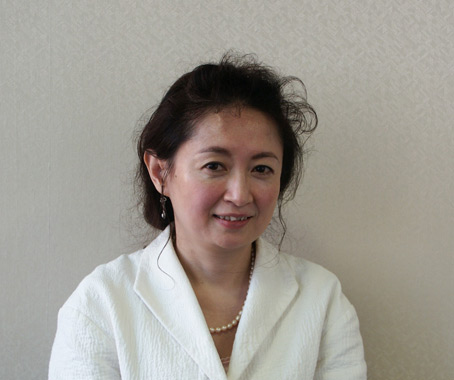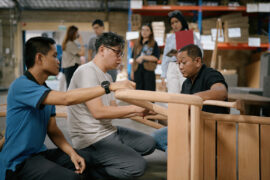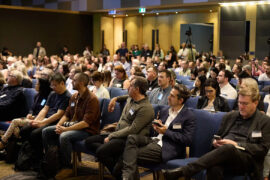Julia Chiu has played a key role in helping to shape Japan’s design policies. She tells us how the country is moving forward and why designs should serve the people.

August 3rd, 2011
Julia Chiu is a very busy woman. Among her many roles, she is executive director of the Japan Institute of Design Promotion, which organises the Good Design Award. Julia also sits on both national and regional councils that advise on Japan’s design policies.
In Singapore recently to judge this year’s President’s Design Award, she tells Indesignlive.asia how the way design is defined, and judged, in Japan has changed in the last few years – as seen in the Good Design Award.

Merry Project, Good Design Award 2010
“It took 8 years to evolve to where it is today in terms of the categorisation [of design],” says Julia. “Today it’s divided into Work, Network, Personal Usage… so it has evolved from looking at the product and defining its category, to looking at it from the user’s point of view.”
This also affects the way works are judged. “I give you an example. There used to be a category for Home Living. We would get the latest refrigerator models from all the different companies and the judges would have to look at the materials, the cost fulfillment, etc. When that system changed, we passed over a refrigerator that was sleek and beautifully designed with the latest functions and we chose a tiny refrigerator designed for the Southeast Asian market,” says Julia.
“It was very simple with all the basic elements, but that simple refrigerator would have opened up new markets reaching out to all the users in Southeast Asia, and that’s what they needed.”

Nepia 1000 Toilets Project, Good Design Award 2009

Medical Herbman Cafe Project, Good Design Award 2010
The biggest change, however, started about 25 years ago with a shift in focus from tangible products and services to intangible things like systems and values, such as community projects, says Julia.
Julia spent 17 years of her career building up the international design centre in Nagoya, Japan and it was here that she grew increasingly preoccupied with how design could go beyond awards, conferences and exhibitions to serve the common folk.
“Next to the design centre there are parks with many homeless people… and it’s in the middle of downtown Nagoya. You see this disparity and you think, I’m doing these beautiful projects, beautiful products, but it doesn’t change the person in ragged clothes. That always bothered me.”
“So somehow over the years, I’ve been moved by very simple, humble products that make a difference to improve a person’s life.”

Shuwa PodChannel, Good Design Award 2010
The concept of ’social design’ has been slow to pick up in Japan, says Julia, but today, she sees a lot of designers in the country starting to work with NPOs on projects to help revive small communities.
More recently, Julia’s business visit to South Africa led to discussions back home with the Japanese Ministry of Economics & Industry from which emerged BOP, a programme where major Japanese companies can apply for subsidies for research into technology and design that meet the needs of developing countries.

Charity Event “RUN for WATER 2010”, Good Design Award 2010
After Japan’s ’triple disaster’ in March, Julia says that “the whole scenario of BOP and social design came in very handy”.
“Today we are a Third World in the midst of the First World; in the whole northeast region you have very poor people, you have refugees in their own countries, their own town. You have old people who have tried to rebuild their lives, you have the phenomenon of young people leaving to work outside of their regions.”
“So I think a lot of what I have been trying to push for came together for a reason, somehow.”
INDESIGN is on instagram
Follow @indesignlive
A searchable and comprehensive guide for specifying leading products and their suppliers
Keep up to date with the latest and greatest from our industry BFF's!

For Aidan Mawhinney, the secret ingredient to Living Edge’s success “comes down to people, product and place.” As the brand celebrates a significant 25-year milestone, it’s that commitment to authentic, sustainable design – and the people behind it all – that continues to anchor its legacy.

Welcomed to the Australian design scene in 2024, Kokuyo is set to redefine collaboration, bringing its unique blend of colour and function to individuals and corporations, designed to be used Any Way!
Luis De Oliveira of De La Espada and Seyhan Özdemir of Turkish design studio Autoban were special guests at Dream Interiors’ cocktail party during Singapore’s Saturday in Design week!
On Friday April 3rd, Chivas Regal transformed a Walsh Bay warehouse into the Chivas Studio.
The internet never sleeps! Here's the stuff you might have missed

The American Hardwood Export Council (AHEC) has collaborated with leading Indonesian designer Hendro Hadinata on the KARANA Collection, unveiled at Indonesia Design Week (IDW).

Tickets for Architecture & Design’s 2025 Sustainability Summit are on sale. This 19 November, engage in ten expert-led panels on urban planning, AI, and circular economy. Join industry leaders in Sydney or online, and gain CPD-accredited insights to drive innovative, sustainable building solutions shaping our shared future. Plus on demand access to recordings.